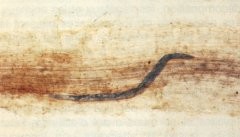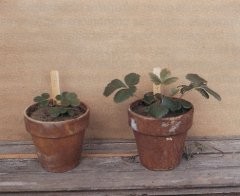Nematodes usually have a wide range of hosts and are seldom confined to a single plant species. Some of the nematodes infesting strawberry and raspberry plantations such as the root lesion nematode can also feed and proliferate on weeds, cereals, trees, and vegetable crops. For this reason rotation does not give an adequate reduction in the nematode population. Rotation with cereals can be successful in reducing root knot nematode as they do not thrive on these crops. Good weed control will eliminate those weed species which support nematode populations.
Treatment during cropping is not considered practical and therefore your nematode assessment and treatment, if required, must be carried out prior to planting. Plant parasitic nematodes can be introduced into a field with nursery plants, another important reason for purchasing certified stock. Certified stock plant production in the Maritimes requires that the nurseries fumigate for nematode control.
Fumigation prior to planting is an effective way to control nematodes. However for both environmental and economic reasons it should only be carried out where soil sampling has been done and nematode numbers are above economic thresholds. Fumigation is preferably done in the fall of the year prior to planting. The soil should be worked several times to a depth of 25 cm in the weeks prior to fumigating to insure that all plant material is decomposed. For a field which was previously in strawberry or raspberry production the only way to be sure that undecomposed plant material is not left in the soil at the time of fumigation is to summer fallow the field and harrow or disc several times during the fallow season. A harrow may be used initially to rake old crowns, canes, or roots to the edge of the field.
Fumigation should be delayed in the fall until late September or early October. It can be carried out earlier but more attention must be paid to obtaining a good seal. The soil must be moist throughout the fumigation depth for at least one week prior to fumigating. The soil should be at 50 to 80% of its water-holding capacity. (A handful of soil in this condition will form a ball when squeezed that will break apart when touched. If it will not form a ball it is too dry and if it will not break apart it is too wet.) Do not fumigate dry soil . The soil should be cultivated so that it is level and with no clods or clumps. The gas that is formed when the fumigant is injected will not penetrate clumps or undecomposed plant material.
Make sure the fumigator is calibrated and that all shanks are delivering the fumigant. The shank depth should be set so that the fumigant treats all the soil in the plough layer. This prevents discing or harrowing from pulling unfumigated soil up into the treated area. For most operations the shanks should be set 20 cm apart and the fumigant injected by setting the shanks 15 to 20 cm deep in the soil. Following the application drag the soil to fill the shank cuts, as fumigant will escape through these slits. Roll the soil to compact and seal and, if necessary, apply water to seal the soil surface and prevent loss of the fumigant to the air. Apply only enough water to wet the soil to a depth of 1 to 1.5 cm. Leave the soil undisturbed until the following spring.
If possible return the empty barrel to the fumigant supplier; otherwise puncture the empty fumigant barrel to prevent it from being re-used and to allow any residual fumigant to evaporate. A barrel treated this way can be deposited at a sanitary landfill after one week.
Cultivate the soil several times at oneweek intervals prior to planting to allow complete aeration of the soil. Do not cultivate deeper than was fumigated. Do not plant if you can still smell the fumigant. If only part of a field is fumigated, cultivate so that the fumigated soil does not become contaminated with unfumigated soil.
Fumigants currently sold in this area contain dichloropropene and related hydrocarbons. In addition, some formulations may contain chloropicrin and methyl isothiocyanate. All products will give an excellent kill of nematodes even when used at the recommended low application rate. Higher fumigation rates are used for fumigating soil for disease control or weed suppression. Fumigation rates therefore fall within a range depending on your reason for fumigating and your soil type (heavier soils require a higher fumigant rate). Obtain the recommended rate from the fumigant supplier for your particular application. Some suppliers will assist you in obtaining the fumigator if you make arrangements adequately in advance. FUMIGANTS ARE HAZARDOUS PESTICIDES - READ AND FOLLOW ALL SAFETY PRECAUTIONS.


